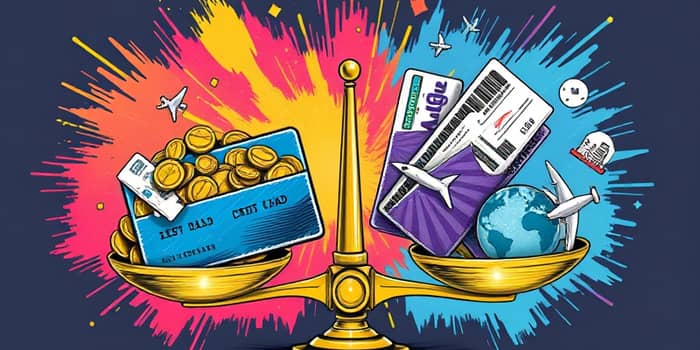Deciding between cash back and travel rewards can feel overwhelming. Both programs promise value, but your lifestyle and goals determine which reigns supreme. This comprehensive guide breaks down every aspect—from earning rates to redemption ease—so you can choose with confidence.
Whether you seek simple, straightforward returns or strive for luxury travel experiences worth maximizing, understanding nuances is key.
Understanding Rewards: Cash Back and Travel Points
At their core, cash back cards return a percentage of your spending as statement credits or deposits. Travel cards, however, award points or miles that you redeem for flights, hotels or transfers to partners.
Cash back programs are prized for their immediate, flexible redemption options—no blackout dates, no partners to track. Travel points, by contrast, offer higher potential value per point when used strategically, but often demand more research and planning.
Earning Rates and Redemption Value
Understanding how much value you get per dollar spent is crucial. Below is a comparison table illustrating typical rates and redemption values.
For cash back, a 2% flat-rate card yields $20 per $1,000 spent. For travel points, earning 3x points plus redeeming at 1.8 cents each nets $54 equivalent per $1,000. But achieving that high redemption rate often involves transfers to airline or hotel partners.
Conversely, if you redeem travel points poorly—like for gift cards—you may see values drop below 1 cent per point, making your rewards inferior to a cash back offering.
Redemption Ease and Restrictions
Cash back redemption is typically painless: statement credits, direct deposits or even checks. Some issuers require a $25 minimum, but most allow instant, no-threshold redemptions.
Travel points involve portals, partner transfers, blackout dates and dynamic pricing. To extract your best value, you often need to monitor award availability, transfer bonuses, and fare rules. This complex booking requirement can deter casual users.
Perks, Bonuses, and Fees
Cash back cards shine with straightforward signup bonuses and low to no annual fees. Typical offers range from $150 to $300 after meeting spend requirements.
Travel cards often provide larger bonuses—50,000–100,000 points—but require higher initial spend within three months. Annual fees can range from $95 on entry-level cards to $695 on premium cards, often offset by lounge credits, hotel credits or statement credits for travel purchases.
Watch out for annual fees and hidden costs, such as foreign transaction fees on cash back cards, which travel cards frequently waive.
Consumer Preferences and Demographics
Surveys reveal clear splits by fee level and user profile:
- Cardholders with fees below $250: 75% favor cash back over points.
- No-fee cardholders: 84% prefer cash back, valuing predictable, immediate returns.
- Premium cardholders ($250+ fee): 52% lean toward travel points; these users skew higher-income and frequent travelers.
- Demographics: Among premium users, 65% male, 35% female; 19% under age 30.
Pros and Cons
- Pros - Cash Back: Easy to use, no travel required, low fees, broad spending categories.
- Cons - Cash Back: Value capped at ~2%–3%, fewer premium perks, smaller signup bonuses.
- Pros - Travel Points: Large sign-up bonuses, access to luxury travel, lounge perks, higher upside per dollar.
- Cons - Travel Points: Complexity in redemptions, risk of devaluation, higher fees, blackout restrictions.
Decision Factors: Which Suits You?
- If you rarely travel and prioritize hassle-free rewards, cash back is your best bet.
- If you travel 2+ times a year and can optimize redemptions above 1.5 cents per point, travel cards offer superior value.
- Consider tracking effort: cash back demands little, travel points require research and flexibility.
- Factor in annual fees: offset a high fee only if you’ll use card perks fully.
Real-World Card Recommendations (2025 Highlights)
Below are standout cards based on current offers and perks. Tailor your choice to spending habits and travel frequency.
- U.S. Bank Cash+ Visa Signature: Choose two categories at 5% back, 1% base.
- PNC Cash Unlimited: 2% on all purchases plus phone protection.
- PayPal Cashback Mastercard: 3% on PayPal transactions, 1.5% elsewhere.
- Chase Sapphire Preferred: 2x points on travel/dining, 1x elsewhere; 60,000-point bonus.
- American Express Platinum: 5x points on flights, lounge access, extensive credits.
Additional Tips and Final Thoughts
Many savvy consumers carry both types of cards—using cash back for everyday expenses and travel points for trips. This double-dipping strategy boosts overall returns.
Monitor program changes: points can be devalued and rules updated. Always read issuer terms and IRS guidance for potential tax implications.
Ultimately, your spending habits and travel goals should dictate the choice. For simplicity and broad value, cash back wins. For aspirational travel and premium perks, travel points deliver unmatched experiences when used wisely.
Choose the path that aligns with your lifestyle, then apply, meet the bonus criteria, and start earning. With the right strategy, every purchase can bring you closer to financial freedom or your next adventure.
References
- https://www.bankrate.com/credit-cards/cash-back/weighing-a-cash-back-card-vs-a-points-and-miles-card/
- https://www.investopedia.com/americans-prefer-cash-back-to-credit-card-points-bank-of-america-survey-finds-11752881
- https://www.moneylion.com/learn/cashback-vs-travel-rewards/
- https://247wallst.com/personal-finance/2025/07/07/the-top-cash-back-card-searches-in-2025-so-far-reveals-some-true-standouts/
- https://thepointsguy.com/credit-cards/cash-back-vs-points-and-miles/
- https://www.nerdwallet.com/best/credit-cards/cash-back
- https://www.youtube.com/watch?v=XTJVKPM93ZM
- https://use.expensify.com/blog/credit-card-statistics










